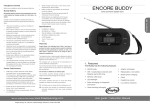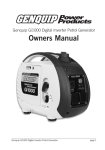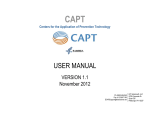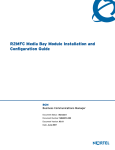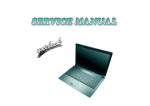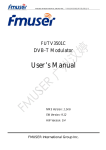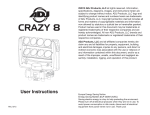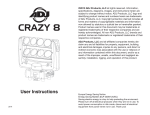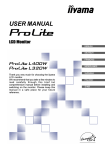Download user instructions & service manual english
Transcript
ENGLISH Figure 2 - control panel an output of between 13V and 21V DC. Refer to the User Manual of the Solar Panel or Wind Generator for detailed instructions on how to recharge batteries. Display Bar Figure 4 www.freeplayenergy.com USER INSTRUCTIONS & SERVICE MANUAL Battery Level Display Switch 12V DC Output Cigarette Lighter Socket 1. INTRODUCTION 2. IMPORTANT SAFETY INFORMATION 3. FEATURES Note: It is strongly recommended that you recharge you FreeCharge after use. 4. OPERATION 4.1 display and controls 4.2 first time use 4.3 recharging the Freecharge Weza 4.4 operating DC appliances 4.5 jump-starting 5. MAINTENANCE AND STORAGE Negative Jumper Terminal 5. FREECHARGE MAINTENANCE AND STORAGE 5.1 battery care 5.2 battery removal and disposal 5.1 Battery Care The FreeCharge contains a sealed Lead Acid battery that should not be stored in a fully discharged state. Prolonged storage of a totally discharged Lead Acid battery may damage it. Fully recharge the Freecharge before storage. The battery self-discharge rate is 5% per month when the unit is stored at a temperature of 68°F. The selfdischarge rate increases with an increase in ambient temperature. In order to prolong battery life when not in regular use, recharge the FreeCharge every 3 months. DC Input Socket 6. PRODUCT SPECIFICATIONS 7. CUSTOMER SUPPORT AND WARRANTY Positive Jumper Terminal 4.4 Operating DC Appliances 5.2 Battery removal and disposal The FreeCharge can power many 12 V DC accessories via the cigarette lighter output socket (Figure 5). The battery inside the FreeCharge is a sealed lead-acid battery. It needs to be removed at the end of its useful life and either recycled or disposed of in accordance with local regulations. When the battery needs replacing, remove it according to the instructions provided in the FreeCharge Service Manual. If you have any questions or problems concerning your unit, please contact the Freeplay Customer Support center. 8. FAQ & TROUBLE SHOOTING 4. OPERATION 4.1 Display and Controls 9. SERVICE MANUAL 1. INTRODUCTION Congratulations on purchasing the FreeCharge Weza Portable Energy Source. The FreeCharge Weza Portable Energy Source is the only booster pack you will ever need. It incorporates failsafe Freeplay technology, in the form of a step charge input, with both AC and DC recharge capability. The FreeCharge provides a truly Portable Energy Source in one compact, rugged unit, for emergency or recreational use, anytime, anywhere. 2. IMPORTANT SAFETY INFORMATION Read these instructions completely before using the FreeCharge and save them for future reference. Read them in conjunction with the user manuals of the particular devices being powered by Freecharge. The FreeCharge contains a sealed LEAD-ACID battery that must be disposed of properly at the end of its useful life. ! Warning: During jump-starting, the receiving lead-acid battery may release explosive gases - ensure that it is well ventilated. Always follow the specific instructions in this manual each time you jump-start using the FreeCharge. General Precautions: # # # # # # # When storing the FreeCharge ensure that it is out of reach of children. When connected to the FreeCharge, the jumper cable clamps may cause sparks if touched together. This could cause damage to the unit. Never charge or boost a frozen battery. Do not submerge the FreeCharge in water. Do not operate in the vicinity of flammables Do not expose the FreeCharge to temperatures over 104F (40C) The lead-acid battery in the FreeCharge is a sealed unit with no free liquid acid. Batteries being jumpstarted with the FreeCharge will likely contain liquid acids, which are hazardous if spilled. Precautions when working with batteries: # # # # # # # Figure 5 6. PRODUCT SPECIFICATIONS Battery Level Indication In the default state the FreeCharge battery level indication is in sleep mode to conserve battery power. Press the battery level display button (figure 2) to display the state of charge of the FreeCharge's internal battery. This will be indicated by the number of lights that are illuminated on the display bar. Six lights indicate a fully charged FreeCharge battery. After 5 seconds the display bar will return to sleep mode. Note: Battery level cannot be displayed while the FreeCharge is being charged. Electrical Specifications Input Effort Indication The amount of human energy transferred into the FreeCharge via step input is indicated on the display bar (Figure 2). The more vigorous the step input, the more energy generated, and consequently the more lights will be illuminated. When step input stops, the display bar will show the battery level for 5 seconds before powering down. Charge Indication When receiving an input charge, the display bar illuminates in a linear pattern. Once the charging source is disconnected, the display bar will display the battery level for 5 seconds before powering down. 4.2 First Time Use Step Input To operate, fold out the stabilizing arms and place the FreeCharge on a level surface. Ensure that you have a firm footing before placing a foot on the input pedal (Figure 3). At a rate of 60-70 steps per minute, the FreeCharge will generate approximately 25 - 40 watts of energy, which is stored in the internal battery. If the input pedal is used, the FreeCharge will immediately display the step input effort indication. Once the step input stops, the display bar will show the battery level for 5 seconds before powering down. Follow manufacturer’s instructions and safety procedures. Ensure that the area around the battery is well ventilated. Never smoke or allow a spark or flame in the vicinity of an engine or batteries. Take care not to allow any metal objects to make contact with the positive and negative terminals simultaneously. This will short circuit the battery causing sparks and possible damage to the battery or electrical equipment, or even cause an explosion. If you need to remove a battery, always remove the negative terminal from the battery first. Wear appropriate protective clothing and avoid touching your eyes after working with batteries. If battery acid comes into contact with skin or clothing, wash immediately with soap and water. If acid enters your eyes, immediately flood them with cold running water and seek immediate medical attention. Figure 3 The FreeCharge is able to deliver a charge or operate an appliance whilst at the same time receive a charge via the DC input charge socket or step input. 4.5 Jump-starting ! Warning: Always connect the jumper cable clamps positive to positive (red clamp to battery positive terminal) and negative to negative (black clamp to battery negative terminal). Never connect in reverse polarity (positive to negative) as this may cause damage to both the FreeCharge and the battery being jump started. ! Warning: The FreeCharge's jump-start feature should only be used in 5-second bursts. A cranking duration in excess of 5 seconds may cause damage to the FreeCharge battery. Ideally the FreeCharge battery should be allowed to recover for at least 2 minutes between jump-start cycles. ! Warning: Always ensure the insulated clamping nuts are secured on the jump-start terminal posts when not in use. If a metal object is placed across the terminal posts it may cause a spark or damage the battery. Step Charge input to provide power anytime, anywhere. Step input effort indication. Runs 12-volt DC products via a cigarette lighter socket Sealed, non-spill 7 amp-hour lead acid battery Jump-starting cables designed for safe and efficient use Internal battery level indicator Rechargeable at home, from a boat, motor vehicle or on the move Service tool kit AC/DC Charging adapter DC charging cable The FreeCharge Weza, with its accessories and tools, is stored neatly in a rugged carry bag. Pedal Battery Disconnect Switch Figure 6 5ft (1.6m) 200 Amps AC/DC Charging Adapter Full charge time Maximum recommended on charge time 18V 1.5 Amps 8 hrs 24hrs DC input socket 13V - 21V (2.1mm center pin positive) Step Input power range Step Input Peak input power 25W - 40W 48W 10.4" x 8.6" x 16.3" (264 x 218 x 414mm) 18.7 lbs (8.5 kg) 2 years 7. CUSTOMER SUPPORT AND WARRANTY Freeplay Customer Support Center: United States and Canada: Dixie Sales, Tel: 1866 6977 529, e-mail: [email protected] United Kingdom: Tango Group, Tel: 0870 6091541, e-mail: [email protected] Rest of the world: e-mail: [email protected] The Freeplay Customer Support Center provides support to FreeCharge Weza Portable Energy Source owners. The FreeCharge Weza has been designed for easy maintenance and servicing and is supplied with a service manual and basic tool kit. For more information about the FreeCharge Weza Portable Energy Source and other Freeplay products please visit our web site at: www.freeplayenergy.com Warranty Issues 2 YEAR WARRANTY The manufacturer undertakes that, if within 2 (two) years of purchase, this appliance or any part thereof is proved to be defective by reason of faulty workmanship or materials, we will, at our option repair or replace the same free of charge for labor or materials on condition that: # Normal wear and tear # Damage through misuse, neglect or damage as a result of alteration either internally or externally, or damaged from improper use or used in an unsuitable environment. # The battery, which has a warranty period of 1 year. AC Source The FreeCharge is supplied with a 18V 1.5A AC/DC adapter. To charge from the AC/DC adapter, plug it into a standard AC wall outlet. Insert the DC output jack of the adapter into the DC input socket of the FreeCharge (figure 4). The display bar lights will illuminate to indicate that the FreeCharge is accepting a charge. After approximately 8 hours (if the battery is totally discharged) the FreeCharge will be fully charged. Ensure that the adapter is disconnected from the FreeCharge within 24 hours to prevent over-charging. When the adapter is disconnected, the display bar will show battery level for 5 seconds before powering down. Vehicles and boats: The FreeCharge is supplied with a DC charging cable that enables charging from the cigarette lighter socket of a vehicle or a boat with a 12 V DC system. A meaningful charge level will only be obtained if the vehicle’s engine is running while connected to the FreeCharge. Plug the one end of the DC charging cable into the FreeCharge's DC input socket (figure 4) and the opposite end into the vehicle's cigarette lighter socket. The display bar will illuminate to indicate that the FreeCharge is accepting a charge. Disconnect the DC charging cable to terminate the charging process. The display bar will then show the battery level for 5 seconds before powering down. Solar panels and Wind generators: The FreeCharge can be charged from a solar panel or wind generator through the DC input socket (Figure 4).The FreeCharge has been designed to accept a DC input voltage of between 13V and 21V. Stabilizer Arm jump-start cable length Cable rating This warranty excludes: To register your warranty online visit www.freeplayenergy.com or alternatively, fill out and post the supplied warranty card (US & UK only). 6. FAQ & TROUBLESHOOTING Please read this section before calling the Freeplay Customer Support Center. Both the Troubleshooting and FAQ are designed to help you solve the most common problems and answer any questions you may have regarding your FreeCharge Weza. DC Source Figure 1 12V 10 Amps (fused, self resettable) 120 Watts # The original invoice or sales receipt (indicating the date of purchase, product type and dealer's name) is presented together with the defective unit. # The complete unit is returned to the manufacturer or representative, postage paid. # All service work is undertaken by the manufacturer or appointed agents. # Any defective unit or part shall become the property of the manufacturer. # This warranty is in addition to your statutory rights. ! Warning: Only use the supplied Freeplay AC/DC Adapter. Input Lever Cigarette Lighter Output Socket Max DC output power Contact the relevant Freeplay Customer Support Center. 3. FEATURES Control Panel 12V 7 Amp-hours sealed lead acid Dimensions (H x W X L) Weight Warranty A switchable voltage DC output cable (not supplied) is available as an accessory, enabling the FreeCharge to power a range of DC appliances of up to 12V with a power consumption of up to 0.4 Amperes. 4.3 Recharging the FreeCharge Battery General Specifications The FreeCharge contains a sealed, non-spill, lead-acid battery that should be kept fully charged for efficient and effective use. The FreeCharge should be recharged when first received, after each use and every 3 months during storage. It is recommended that the FreeCharge be fully charged before planning a trip. ! Warning: Refer to the "Precautions When Working With Batteries" in the front of this manual. # # # # # # # # # # # # Crank the engine in 5 second cycles with rests in between as specified above. Jump-starting with a discharged FreeCharge Battery: In the event that the FreeCharge battery is in a state of discharge the step input system may be used to charge the vehicle battery directly. To do this, follow the procedure below: # disconnect the FreeCharge internal battery using the battery disconnect switch (figure 1) located behind the rubber cover on the outer casing. Loosen both bolts and slide the metal switch completely to the left. Re-tighten the bolts to retain the metal switch in the “open” position. # Switch off the ignition and other power consuming systems and connect the jumper cables as detailed above. # Operate the step input pedal at a rate of 60 - 70 treads per minute for several minutes. Larger engines may require in excess of 5 minutes of input effort in order to provide the vehicle battery with enough energy to crank the engine. Because you have disconnected the FreeCharge internal battery, all the energy you are generating is used to charge the vehicle battery directly. # After the engine has started, disconnect the black negative clamp and then the red positive clamp from the battery terminals. # Finally, remove the jumper cables from the FreeCharge, ensure the insulated clamping nuts are secured on the terminal posts and restore the “battery disconnect switch” to the closed position (completely to the right) with its 2 bolts securely fastened. Ensure that the input jack from the solar panel or wind generator is the correct size and polarity (2.1mm center pin positive). ! Warning: The Solar panel or Wind generator output must be intended for battery charging and have FAQ Jump-starting with a fully charged FreeCharge battery: The FreeCharge should ideally be fully charged before attempting to jump-start a boat or vehicle engine check the battery level by pressing battery level display button (figure 2). If there is insufficient energy, recharge the FreeCharge from an AC or DC source. # Turn the ignition off # Ensure that any other power consuming systems e.g. lights, radio etc are also turned off. # Ensure that the ‘Battery Disconnect Switch” under the rubber cover on the outer casing of the FreeCharge is in the closed position with the bolts firmly tightened. # Connect the jumper cables to the FreeCharge. The red cable must be attached to the red positive terminal (+) and the black cable to the black negative terminal (-) of the FreeCharge (Figure 6). Ensure that the clamping nuts are securely fastened to prevent the jumper cables from working loose. # Connect the FreeCharge's red positive clamp to the positive (+) battery terminal (it usually has a red wire connected to it). Then attach the black negative clamp to the negative (-) battery terminal. # For best results the FreeCharge and the receiving battery should remain connected for several minutes before attempting to crank the engine. This allows the FreeCharge to transfer energy to the receiving battery, improving cranking performance Q: Can the FreeCharge's internal battery be replaced? A: Yes, please consult your service manual or contact the Freeplay Customer Support Center for advice. Q: I have a regular 5 Amp battery charger with crocodile connector clips, can I use it to charge the FreeCharge through the terminal posts? A: Yes Q: How do I know when the FreeCharge is fully charged? A: Read all recharging instructions in the user manual. The lights on the display bar indicate charge level. Q: How can I test the battery in the FreeCharge to see if it needs to be replaced? A: The Manufacturer recommends that you use a 100 Amp battery load tester. Load the FreeCharge with a 100 Amp load (on terminal posts) and it should maintain at least 9 V DC. Q: What products can my FreeCharge power or recharge? A: most products compatible with a 12V DC power source. Q: Is using the Step Input the only means to charge my FreeCharge? A: No. The FreeCharge can also be charged from either a DC or AC power source. Q: How long will it take to charge my FreeCharge from the wall socket with the AC/DC charging adapter? A: It will take approximately 8 hours to fully charge the FreeCharge. Q: Can I charge my 12V DC device while the FreeCharge is being charged either through the DC input or via the Crank? A: Yes. Q: What materials are used in the FreeCharge and are they recyclable? A: The casings are made of polypropylene and glass-filled nylon. The transmission is made of a combination of acetyl, glass-filled nylon and aluminum, while the input levers, pedal and stabilizer arms consist of a glass-filled nylon. All plastic materials used are thermoplastics and can be recycled. The FreeCharge contains a non-spill rechargeable Lead Acid battery, which needs to be recycled according to regulations stipulated by your local authority. Please consult your user manual or contact the Freeplay Customer Support Center for more advice. Q. How long will a fully charged battery retain its charge? A: The battery will self-discharge at 5% per month when the unit is stored at a temperature of 68°F. The selfdischarge rate increases with an increase in ambient temperature. Q. Will I damage the FreeCharge if I crank the pedal too fast? A. No, the faster you crank the more energy you store in the internal battery. Q: Can I over-crank the unit - does it ever stop you from cranking? A. No, you cannot over-crank the internal mechanism. It consists of simple gearbox, which drives an alternator, providing power to the internal battery. Q: What type of rechargeable battery is used in the FreeCharge? A. The FreeCharge incorporates a non-spill rechargeable 12 V 7 Amp hour Lead Acid battery. 9. SERVICE MANUAL DISASSEMBLING THE FREECHARGE WEZA Sequence of disassembly (Figure 11) Figure 10 Figure 9 NOTE: # The FreeCharge is supplied with a tool kit to enable disassembly. # Left and right components - these are defined when viewing the FreeCharge from its pedal end. # The input levers and stabilizer arms must first be removed before the outer, and then the inner casings can be opened. DO NOT remove the stabilizer arm pivot shaft (Figure 8, D) from the main assembly if you are not intending to split the 2 inner casings, as the internal spring is attached to this shaft (Figure 10, A). # The input levers and splined drive shaft have an indexing tooth (which has a rounded tip) and should only be assembled in their correct indexed orientation(Figure 7). # The gearbox and alternator are located under the outer left casing. # The battery and bolts to release the control panel assembly are located under the right outer casing. # The 5 bolts to split the inner casings (Figure 8, E) are located in the inner right casing (battery compartment) and are accessed by removing the right outer casing. # The drive shaft assembly, drive belt and return spring are located within the inner casings. PART REPLACEMENT 1. Replacing an Input Lever and Pedal Remove the input lever by unscrewing 2 bolts, one located at the pivot end of the input lever and the other at the pedal end. Work the input lever off the drive shaft and the pedal shaft. The pedal consists of 2 halves which can be removed once one of the input levers has been removed. The input levers and splined drive shaft have an indexing tooth and should only be re-assembled in their correct indexed orientation (Figure 7). The pedal halves should be assembled with the diamond pattern facing upward. 2. Replacing a Stabilizer Arm Q: How long does the warranty last? A. The FreeCharge has a 2 year warranty Figure 7 considerable resistance due to the alternator magnets). Loosen the 4 bolts and remove the alternator, drawing its 3 wires from the conduit to the battery compartment. Pull the rotor cup off the base plate of the replacement alternator. Bolt the base plate to its mountings on the left inner casing. Feed the 3 wires through to the battery compartment and reconnect at the connector block in the battery compartment (Figure 8, A). The order of connection does not matter. Replace the rotor cup (figure 9, C). Replace the other components by reversing the disassembly procedure. Q: Can I leave my FreeCharge charging from an AC wall charger all the time and unplug it when I need to use it? A: The FreeCharge should not be left on charge for longer than 24 hours. Q: Should I discharge the FreeCharge's internal battery before recharging? A: No. The FreeCharge contains a non-spill Lead Acid battery, which does not require total discharge before recharging. Leaving a Lead Acid battery in a fully discharged state for an extended period of time will cause damage to the battery and limit its life. TROUBLESHOOTING 7. Replacing the Drive Shaft Assembly or the Drive Belt and Spring # The FreeCharge will not accept a Charge from a DC source. Remove the right input lever and right stabiliser arm. Remove the right side outer casing by removing its 5 bolts. Remove the battery and control panel, as described previously. Remove the 5 bolts which lock the inner casings (figure 8, E) and the circlip and washer on the input shaft (figure 8, C). Disconnect the 3 alternator wires at the connector block (figure 8, A). Pull away the right inner casing feeding the alternator wires through their conduit and leaving the internal parts assembled in the left inner casing. Unhook the spring from the stabilizer arm pivot shaft (figure 10, A) and pull the drive shaft assembly together with the attached belt and spring free (Figure 10, B). Remove 2 bolts (figure 10, C) to detach the belt together with the spring from the drive shaft assembly. Reverse this procedure to reassemble making sure that the belt is tracked correctly under the belt retaining bush (figure 10, D) and over the toothed input pulley (figure 10, E) before re-hooking the spring end to the stabilizer pivot shaft (figure 10, A). Make sure that the input lever arms are indexed correctly to the drive shaft assembly when reassembling (figure 7). Symptom The display bar does not illuminate to show that the FreeCharge is receiving a charge. Possible Cause Solution The DC source has insufficient power to charge the FreeCharge or is faulty. The FreeCharge will not accept a charge from a DC source that has a voltage lower than 13 volts. Disconnect the FreeCharge from the DC source. Charge the FreeCharge by using either the Step Input or the AC charging adapter. The voltage of the DC source is too high for the FreeCharge (over 25 Volts) and has burnt out the charge electronic circuitry. Replace the control panel unit. A faulty charging cable Replace charging cable Incorrect polarity Check polarity Remove a stabilizer arm by removing 2 bolts. Work the stabilizer arm off the stabilizer pivot shaft and the stabilizer locking shaft. DO NOT remove the stabilizer arm pivot shaft (figure 8, D) from the main assembly if you are not intending to split the 2 inner casings, as the internal spring is attached to this shaft. Reverse this procedure to re-assemble. Symptom The display bar does not illuminate after plugging in and switching on the AC/DC adapter A faulty AC adapter Check or Replace the AC adapter Remove the battery as described previously. Remove the leads to the battery disconnect switch terminals located in the right outer casing. Disconnect the 3 alternator wires at the connector block (figure 8, A) and release the wires from their cleats. Remove the 2 bolts that hold the control panel in place (figure 8, B). The control panel unit can now be pulled free, feeding the cables and the 3 alternator wires through the aperture in the right inner casing. The control panel is replaced by reversing this procedure. Symptom The appliance does not operate. 120 308 028 030 032 206 114 112 214 208 116 206 108 302 206 Figure 8 Replace the internal battery 216 040 008 104 208 034 206 210 208 102 018 122 106 Solution Recharge the FreeCharge using, either an AC source, DC source or the step input. After charging confirm the charge status by pressing the “Display Battery Level” button. 124 016 104 314 036 038 006 316 # The FreeCharge cannot jump start a boat or vehicle's engine. 110 Solution Recharge the FreeCharge using an AC or DC source. After charging confirm the charge status by pressing the “Display Battery Level” button. Alternatively, disconnect the FreeCharge’s internal battery with the ‘battery disconnect switch’ and use the step charge input to recharge the receiving battery directly. The engine receiving is in poor condition. Replace the receiving battery. The engine's cranking amps requirements exceeds the FreeCharge's jump start capability ** It is not possible to jump start this particular engine using FreeCharge. 110 204 Solution Internal gears and mechanism are damaged. Consult the Service manual or contact the Freeplay Customer Service Center. # The display bar does not work Solution The FreeCharge is totally discharged. Recharge the FreeCharge. The FreeCharge internal battery is damaged. Replace the internal battery. The electronic circuitry is damaged. Contact the Freeplay Customer Service Center. 004 208 PART NAME PART No. KEY PART NAME PART No. KEY PART NAME PART No. 002 Left Input Lever 114-ILL-GOL 036 Stabilizer Locking Shaft 016-SS-GOL 204 Serrated Washer 200-W-S-M10 004 Left Stabilizer Arm 012-SL-GOL-A 038 Stabilizer Pivot Shaft 016-SS-GOL 206 Bolt 200-CS-M6x20 006 Left Outer Casing 002-COL-GOL 040 Positive Clamping Nut 038-PNG-GOL-RED 208 Serrated Washer 200-W-S-M6 008 Left Rear Foot 010-FBL-GOL 042 Negative Clamping Nut 038-PNG-GOL-BLK 210 Washer 200-W-M6 010 Left Front Foot 008-FFL-GOL 102 Gear Plate 005-GP-GOL 212 Countersunk Bolt 200-CS-C-M4x12 012 Left Inner Casing 001-CIL-GOL-A 104 Secondary Gear Bearing 144-SGB-GOL 214 Circlip 200-CC-EX-36 014 Control Panel Gasket 032-PG-GOL 106 Secondary Gear 142-SGP-GOL-A 216 Circlip 200-CC-EX-23 016 Right Inner Casing 003-CIR-GOL-A 108 Input Gear 140-IGH-GOL-A 218 Bolt 200-CS-M6x10 018 Right Front Foot 009-FFR-GOL 110 Alternator 100-ALT-GOL 302 Positive Jumper Cable 017-JC-GOL-A-RED 020 Right Rear Foot 011-FBR-GOL 112 Input Shaft 103-IS-GOL 304 Negative Jumper Cable 017-JC-GOL-A-BLK 022 Right Outer Casing 004-COR-GOL 114 Clutch Bearing 112-CB-GOL 306 Control Panel Unit 030-IP-GOL-A 024 Right Input Lever 115-ILR-GOL 116 Toothed Pulley 111-TP-GOL 308 Battery 300-BAT-GOL 026 Battery Switch Cover 043-BSG-GOL 118 Drive Belt 107-TB-GOL 310 Battery Switch Lead 300-BLS-GOL 028 Pedal Top 120-PT-GOL 120 Input Shaft Washer 125-ISW-GOL 312 Battery Switch 044-BS-GOL 030 Pedal Shaft 118-LB-GOL 122 Drive Shaft Assembly 102-DS-GOL-A 314 AC/DC Charging Adapter 600-ACDC-GOL 032 Pedal Bottom 121-PB-GOL 124 Return Spring 104-TS-GOL 316 DC Charging Cable 601-DCCC-GOL 034 Right Stabilizer Arm 013-SR-GOL-A 202 Bolt 200-CS-BH-M10x25 318 Selectable DC Output Adapter (not supplied) 602-SVDCO-GOL KEY Remove the left input lever and left stabilizer arm as described previously. DO NOT remove the stabilizer arm pivot shaft from the main assembly if you are not intending to split the 2 inner casings, as the internal spring is attached to this shaft. Remove the left outer casing by removing 5 bolts. Remove the gear plate by removing 3 bolts(Figure 9, A). The secondary gear can now be removed or replaced. Remove the circlip from the input shaft (figure 9, B) to remove or replace the input gear. 6. Replacing the Alternator Symptom The display bar does not illuminate. 318 206 5. Replacing Gear Components Possible Cause 212 206 202 # The Step Input does not work Symptom The Input arm is either stuck or has no resistance. 010 208 **Cranking Amps are a measure of how much power a battery can supply to start an engine at 32º F. Possible Cause 012 002 Symptom The engine is not turning over Possible Cause The FreeCharge's battery is not sufficiently charged 312 206 208 118 304 4. Replacing the Control Panel # The FreeCharge cannot operate or charge an appliance from is cigarette lighter DC output socket. 022 306 014 Solution 310 026 218 Remove the right input lever and right stabilizer arm as described above. Remove the right side outer casing by removing its 5 bolts. The casing will come away partly, as the battery is attached to it. The battery should now be visible and its 2 terminals should be accessible. Disconnect the wires from the battery by undoing the bolts and remove the battery. To insert a new battery, reverse the procedure above. Ensure that the wires are connected to the correct terminals. The red wire to the positive terminal and the black wire to the negative terminal. Possible Cause The FreeCharge's internal battery is damaged 042 3. Replacing the Battery # The FreeCharge will not accept a charge from the AC/DC adapter. Possible Cause The FreeCharge's internal battery is discharged. 020 Figure 11 218 206 202 204 210 024 Remove the right and left input lever and the right and left stabilizer arms as described above. DO NOT remove the stabilizer arm pivot shaft from the main assembly if you are not intending to split the 2 inner casings, as the internal spring is attached to this shaft. Remove the right outer casing by removing 5 bolts. Disconnect the battery as described above. Disconnect the 3 alternator wires at the connector block (Figure 8, A). Remove the left outer casing by removing 5 bolts. Remove the gear plate by removing 3 bolts (Figure 9, A). Remove the secondary gear. To gain access to the 4 bolts that fasten the alternator to the left inner casing, pull the rotor cup off its base plate (figure 9, C). Do not lever the rotor cup off, but pull in a straight line so as not to cause damage. (There will be


